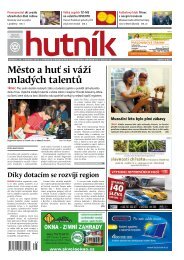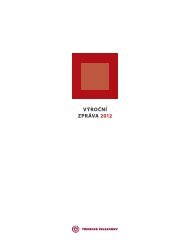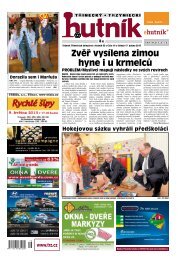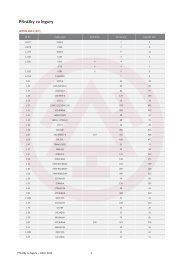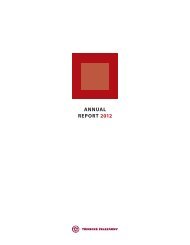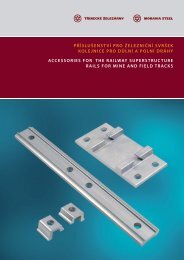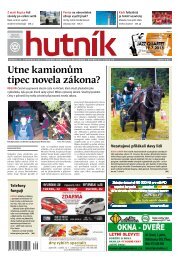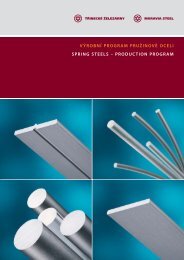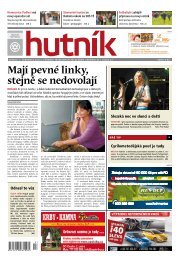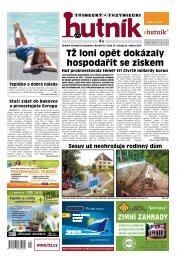TŽ Annual Report 2008 in pdf, 7.5 MB - TÅinecké železárny
TŽ Annual Report 2008 in pdf, 7.5 MB - TÅinecké železárny
TŽ Annual Report 2008 in pdf, 7.5 MB - TÅinecké železárny
- No tags were found...
You also want an ePaper? Increase the reach of your titles
YUMPU automatically turns print PDFs into web optimized ePapers that Google loves.
3.Characteristics of the Production PlantsSteel Production <strong>in</strong> Tř<strong>in</strong>ecké železárny Includes the Follow<strong>in</strong>g Facilities:In the Coke-Chemical Production plant, the production of coke for the needs of the company’s blast furnaces takes place. Two cokeovenbatteries of Koppers design heated by blended or cok<strong>in</strong>g gas work with ramm<strong>in</strong>g operation. They are equipped with the facility forwet quench<strong>in</strong>g of coke. The coke gas is desulphurised and supplied to the gas networks of Tř<strong>in</strong>ecké železárny for subsequent utilisation.Numerous coke chemical products, especially crude cok<strong>in</strong>g tar, benzyl, and ammonium sulphate are produced <strong>in</strong> the consecutivechemical section.The Iron and Steel Production plant comprises: • production of hot iron; and • steel production.S<strong>in</strong>ter is the basic metal-bear<strong>in</strong>g raw material for the production of hot iron. It is produced <strong>in</strong> two s<strong>in</strong>ter<strong>in</strong>g plants; each equippedwith two s<strong>in</strong>ter<strong>in</strong>g belts. In 2007 and <strong>2008</strong>, the renovation of electrostatic separators at s<strong>in</strong>ter plant No.1 took place which significantlyreduced the amount of air pollution. The <strong>in</strong>put material of the s<strong>in</strong>ter<strong>in</strong>g plants consists of the powdery iron ores, dolomite, lime,pulverised coke, and reverse charg<strong>in</strong>g material result<strong>in</strong>g from production processes.The pig iron production itself takes place <strong>in</strong> two blast furnaces with bell-free throats equipped with automated control of furnaceoperation. Hot iron is transported to the converter plant <strong>in</strong> torpedo cars.More than 98 percent of the Tř<strong>in</strong>ec steel is produced <strong>in</strong> the BOF converter plant based on the process<strong>in</strong>g of hot iron with oxygen. Theplant is equipped with top ladle metallurgy facilities, which enable chemical and temperature homogenisation, alloy<strong>in</strong>g, preheat<strong>in</strong>g, andvacuum degass<strong>in</strong>g of steel. Converter steel is mostly cast at two cont<strong>in</strong>uous cast<strong>in</strong>g mach<strong>in</strong>es; approximately 5 percent of steel is teemed<strong>in</strong>to <strong>in</strong>gots, especially the special steel grades. Cont<strong>in</strong>uous cast<strong>in</strong>g mach<strong>in</strong>e No. 1 is of a five-strand design, with the possibility of cast<strong>in</strong>grectangular blooms of 300 x 350 mm and circular blooms of diameters 320, 410, and 525 mm. The eight-strand cont<strong>in</strong>uous cast<strong>in</strong>gmach<strong>in</strong>e No. 2 enables the cast<strong>in</strong>g of square billets with sides of 150 mm. The automatic control system controls the whole converterprocess <strong>in</strong>clud<strong>in</strong>g the gas clean<strong>in</strong>g station. The small EAF steel plant produc<strong>in</strong>g special steel grades is also a part of the steel productionsection.The metallurgical cycle is concluded by roll<strong>in</strong>g mills, which are the most complex manufactur<strong>in</strong>g units. They consist of the roll<strong>in</strong>g millof blooms and heavy sections, roll<strong>in</strong>g mill of wire rod and light sections <strong>in</strong> Tř<strong>in</strong>ec, and the universal strip mill <strong>in</strong> Bohumín.The semis are delivered for further process<strong>in</strong>g that ensures an <strong>in</strong>crease <strong>in</strong> added value to: Sochorová válcovna TŽ located <strong>in</strong> Kladno,Válcovna trub TŽ located <strong>in</strong> Ostrava-Vítkovice and VÚHŽ <strong>in</strong> Dobrá.Accord<strong>in</strong>g to technology, the Roll<strong>in</strong>g Mill of Blooms and Heavy Profiles is divided <strong>in</strong>to two production l<strong>in</strong>es: • bloom<strong>in</strong>g mill andrevers<strong>in</strong>g mill; and • medium section mill.The cont<strong>in</strong>uously cast semis and <strong>in</strong>gots are rolled at the bloom<strong>in</strong>g mill <strong>in</strong>to slabs and blocks, and then at the revers<strong>in</strong>g mill <strong>in</strong>to billets,heavy profiles, special profiles for railway accessories and rails. The medium section mill produces round bars, flat bars, sections forrailway accessories, parabolic spr<strong>in</strong>gs, and m<strong>in</strong>e rails.The Roll<strong>in</strong>g Mill of Wire Rod and Light Section plant consists of: • cont<strong>in</strong>uous light section mill; and • cont<strong>in</strong>uous wire rod mill.The product portfolio produced at the cont<strong>in</strong>uous light section mill <strong>in</strong>cludes round bars and coils, flat bars, hexagons, rebar, and angles.The mill was largely modernised; one of the results of the modernisation was the expansion of the product mix by special bar qualityproducts. A substantial part of the output of the light section as well as wire rod mill is processed at the f<strong>in</strong>alis<strong>in</strong>g facilities enabl<strong>in</strong>gheat treatment, peel<strong>in</strong>g, draw<strong>in</strong>g, or the comb<strong>in</strong>ation of those operations based on customer specifications <strong>in</strong>clud<strong>in</strong>g the <strong>in</strong>spection ofsurface and <strong>in</strong>ternal defects.4



